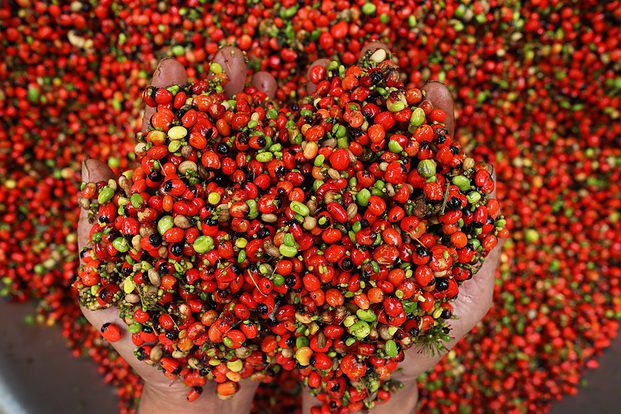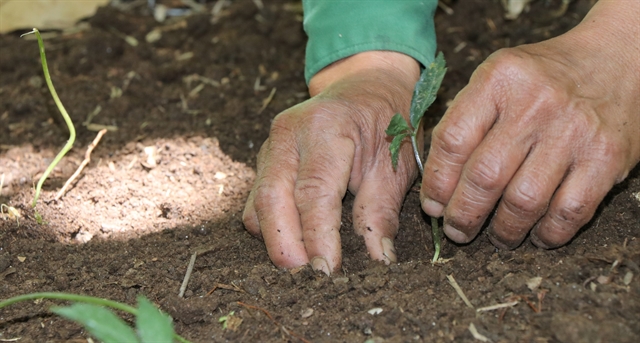 Society
Society

m h

|
| Ngọc Linh ginseng has a beautiful red colour when ripe. Photo samngoclinhkontum.com |
QUẢNG NAM — Việt Nam should improve the quality and quantity of Ngọc Linh ginseng, improving its competitiveness against ginseng powerhouses like Japan, South Korea and the US, according to officials, scientists and business leaders at a recent seminar held in the central province of Quảng Nam.
Titled “Turning Ngọc Linh ginseng into a national brand”, the seminar was organised by Tuổi Trẻ (Youth) newspaper in coordination with the People’s Committees of Quảng Nam and Kon Tum provinces on Saturday.
Ginseng researchers, brand development experts, and representatives of the agriculture, industry and trade and tourism ministries, as well as representatives of ginseng businesses, discussed policies and solutions to further expand Ngoc Linh ginseng farming areas as well as promote the product in the international market.
President Nguyễn Xuân Phúc also attended the event and gave directions on developing the precious plant, which is found only on Ngọc Linh mountain of Việt Nam.
He hailed the two provinces of Kon Tum and Quảng Nam for their efforts to preserve and develop Ngọc Linh ginseng.
Citing Ngọc Linh ginseng as a national treasure that can help provide jobs and livelihoods for local people, the President said the ginseng would be a new hope in pharmaceutical and dietary supplement sectors of Việt Nam.
He added that the ginseng will help the country compete with Japan, South Korea, and China, which produce a large amount of ginseng and hundreds of products from the plant.
Though Việt Nam has been producing an increasing amount of ginseng, he noted that the country’s productivity is still limited and the quality needs to be improved.
The president pointed out major problems including changes in weather and climate that cause ginseng to die, the appearance of fake ginseng, and limited science and technology, especially in the conservation of seed sources.
The head of the State said given Ngọc Linh ginseng’s great potential both in health and economic terms, it is completely reasonable to develop a billion-dollar ginseng industry.

|
| Ginseng is planted in the central highland province of Kon Tum. VNA/VNS Photo |
He noted that there is a lot to work being carried out in a serious and systematic way, from not only the two provinces of Kon Tum and Quảng Nam, but the Government, ministries and agencies.
He highlighted the need for both preservation and development of ginseng with priority given to quality products.
He suggested ginseng producers and research agencies learn from South Korea, aiming to bring this to the general public within the country and also international markets.
He requested that the purebred gene ginseng sources must be protected and that Ngọc Linh ginseng must be a national brand, not merely a trademark of an enterprise.
He also ordered advanced technology to be used to make this a competitive product in the global ginseng market.
Noting that land and forest areas are crucial factors in the ginseng industry, the President said people and businesses need to cooperate closely to preserve such locations.
The President said he hoped the two provinces will implement the breeding strategy to bring Ngọc Linh ginseng to the domestic and global markets.
He also noted that the province should learn from the South Korean model, and turn Việt Nam’s Ngọc Linh ginseng into a national brand and treasure.
According to Hồ Quang Bửu, Vice Chairman of Quảng Nam’s People’s Committee, more than 1,600ha of forest in the province has been leased by businesses, households and individuals for growing the ginseng.
Ginseng growers’ lives and incomes have improved considerably with many businesses now worth dozens of billions of dong.
However, there are many problems to be solved in turning ginseng into a national brand.
Vũ Thành Nam, deputy director of the Special-use and Protective Forest Management Department under the Forestry General Office, said the development of ginseng is not commensurate with its potential.
He noted problems such as a lack of planning for the development of raw materials, lack of seed sources (both in quantity and quality), and limited advertising, promotion, and branding.
According to Trần Út, vice director of Quảng Nam’s Department of Agriculture and Rural Development, the current ginseng production area in the province is more than 1,000 ha and the total area planned for ginseng production and preservation is 15,576ha.
He noted some limitations including widely traded fake ginseng which affects customers’ confidence and authentic ginseng growers.
Meanwhile, the technology applied in inspection and monitoring of ginseng origin has not been developed, causing difficulties in management, he said.
Út suggested that ginseng production be identified as a key economic sector, and ginseng should be produced and developed in a sustainable way.
He also highlighted the need for forest management and protection as well as ecotourism and community-based tourism development.
Hoàng Minh Chiến, deputy head of the Trade Promotion Department under the Ministry of Industry and Trade, said it is important to increase promotion campaigns for Ngọc Linh ginseng both domestically and internationally.
He suggested we implement a promotion strategy to target importers to increase brand identity and build the image of Việt Nam’s ginseng industry in international markets.
Ngọc Linh ginseng was first discovered in 1973 in a forest on Ngọc Linh mountain, located between the two provinces of Kon Tum and Quảng Nam by a team of four pharmacists. They were sent by the Central Region Health Agency to search for herbal medicine.
Ngọc Linh ginseng's stems and roots contain a high rate of saponin compound, much higher than other ginseng species. The ginseng also has preeminent features that Korean and Chinese ginseng lack. These include important antibacterial, anti-depressant, anxiety-reduction and anti-oxidant properties, and can boost the effects of antibiotics and diabetes medication.
It is estimated that for an investment of about VNĐ3 billion (nearly US$129,000) to grow one hectare of ginseng, revenue after five years can reach VNĐ30 billion.
However, growing Ngọc Linh ginseng isn’t an easy feat because the plant can only grow and produce quality ginseng in climatic and soil conditions at an altitude of 1,200-2,000m on Ngọc Linh mountain. VNS